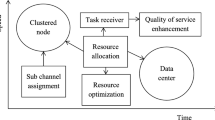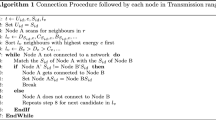Abstract
In a scalable ad-hoc network, which is deployed in a large area with many nodes, it is difficult to maintain global time synchronization among all nodes in a whole network. Considering this problem, a local synchronization-based system is presented to discover neighboring nodes in a scalable wireless network. With the proposed system, a whole ad-hoc network is composed of several subgroups and local time synchronization is maintained within each subgroup. For the proposed system, the transmitter and receiver operations of a node are presented to discover neighboring nodes. The most important parameter for power consumption is the duty cycle of a node, defined as the ratio between the receiver turn-on time and total considered time. The duty cycles of the proposed system and cyclic quorum-based power management (CQPM) are compared by analysis. In addition, the power consumptions of the proposed system and CQPM are compared by simulation. The results show that the proposed system can reduce the power consumption of a node significantly in a scalable ad-hoc network.












Similar content being viewed by others
References
Basagni, S., Giordano, M. C. S., & Stojmenovic, I. (2004). Mobile ad hoc networking. New York: IEEE Press.
IEEE Standard 802.11. (2012). IEEE standard for information technology, telecommunications and information exchange between systems, local and metropolitan area networks, specific requirement part 11: Wireless LAN MAC and PHY specifications.
Nosovic, W., & Todd, T. D. (2002). Scheduled rendezvous and RFID wakeup in embedded wireless networks. In Proceedings of IEEE international conference on communications, New York, USA, 2002, pp. 3325–3329.
Wu, S. L., Tseng, P. C., & Chou, Z. T. (2005). Distributed power management protocols for multi-hop mobile ad hoc networks. Computer Networks, 47(1), 63–85.
Zheng, R., & Kravets, R. (2003). On-demand power management for ad hoc networks. In Proceedings of IEEE INFOCOM, San Francisco, USA, pp. 481–491.
Romer, K. (2001). Time synchronization in ad hoc networks. In Proceedings of International Symposium on Mobile Ad Hoc Networking & Computing, New York, USA, pp. 173–182.
Blum, J., Eskandarian, A., & Hoffman, L. (2004). Challenges of intervehicle ad hoc networks. IEEE Transactions on Intelligent Transportation Systems, 5(4), 347–351.
Indira, S. (2014). A survey on energy efficient protocols in mobile ad hoc networks. International Journal of Advances in Computer Science & Technology, 3(6), 390–394.
Bekmezci, I., Sahingoz, O. K., & Temel, S. (2013). Flying ad-hoc networks (FANETs): A survey. Ad Hoc Networks, 11(3), 1254–1270.
Orlinski, M., & Filer, N. (2012). Movement speed based inter-probe times for neighbour discovery in mobile ad-hoc networks. In Proceedings of international conference on ad hoc networks, Paris, France, pp. 316–331.
Tseng, Y. C., Hsu, C. S., & Hsieh, T. Y. (2003). Power saving protocols for IEEE 802.11 based multihop ad hoc networks. In Proceedings of IEEE INFOCOM, New York, USA, pp. 200–209.
Choi, B., & Shen, X. (2011). Adaptive asynchronous sleep scheduling protocols for delay tolerant networks. IEEE Transactions on Mobile Computing, 10(9), 1283–1296.
Zheng, R., Hou, J. C., & Sha, L. (2003). Asynchronous wakeup for ad hoc networks. In Proceedings of International Symposium on Mobile Ad Hoc Networking & Computing, Annapolis, USA, pp. 35–45.
Jiang, Z. R., Tseng, Y. C., Hsu, C. S., & Lai, T. H. (2005). Quorum-based asynchronous power saving protocols for IEEE 802.11 ad hoc networks. Mobile Networks and Applications, 10(1–2), 169–181.
Chou, Z. T. (2007). Optimal adaptive power management protocols for asynchronous wireless ad hoc networks. In Proceedings of wireless communications & networking conference, Hong Kong, pp. 61–65.
Chao, C., Sheu, J., & Chou, I. (2006). An adaptive quorum-based energy conserving protocol for IEEE 802.11 ad hoc networks. IEEE Transactions on Mobile Computing, 5(5), 560–570.
Wu, S., Chen, M., & Chen, C. (2014). Optimally adaptive power-saving protocols for ad doc networks using the hyper quorum system. IEEE/ACM Transactions on Networking, 22(1), 1–15.
Wu, S., Chen, M., & Chen, C. (2008). Fully adaptive power saving protocols for ad hoc networks using the hyper quorum system. In Proceedings of international conference on distributed computing systems, Beijing, China.
Wu, S., Sheu, J., & King, C. (2013). Unilateral wakeup for mobile ad hoc networks with group mobility. IEEE Transactions on Mobile Computing, 12(12), 2507–2517.
Wu, S., Sheu, J., & King, C. (2011). Unilateral wakeup for mobile ad hoc networks. In Proceedings of international conference on parallel processing.
Younis, O., & Fahmy, S. (2004). HEED: A hybrid, energy-efficient, distributed clustering approach for ad hoc sensor networks. IEEE Transactions on mobile computing, 3(4), 366–379.
Bukhari, S. H. R., Rehmani, M. H., & Siraj, S. (2015). A survey of channel bonding for wireless networks and guidelines of channel bonding for futuristic cognitive radio sensor networks. IEEE Communications Survey & Tutorials, 18(2), 924–948.
Akyildiz, I., Lo, B., & Balakrishnan, R. (2011). Cooperative spectrum sensing in cognitive radio networks: A survey. Journal of Physical Communication, 4(1), 40–62.
Akhtar, F., Rehmani, M. H., & Reisslein, M. (2016). White space: Definitional perspectives and their role in exploiting spectrum opportunities. Telecommunications Policy, 40(4), 319–331.
Rehmani, M. H., Viana, A. C., Khalife, H., & Fdida, S. (2011). Improving data dissemination in multi-hop cognitive radio ad-hoc networks. In Proceedings of international conference on ad hoc networks, Paris, France, pp. 117–130.
Bukhari, S. H. R., Siraj, S., & Rehmani, M. H. (2016). PRACB: A novel channel bonding algorithm for cognitive radio sensor networks. IEEE Access, 4, 6950–6963.
Singer, J. (1938). A theorem in finite projective geometry and some applications to number theory. Transactions of the American Mathematical Society, 43(3), 377–385.
Goldsmith, A. (2004). Wireless communications. Cambridge: Cambridge Univ Press.
Bluegiga. (2013). WF111-802.11 B/G/N Module, datasheet.
Acknowledgements
This work was supported in part by the National Research Foundation of Korea (NRF) funded by the Korean Government (MSIP) under Grant NRF-2015R1A2A2A01005211, and in part by the research fund of Hanyang University.
Author information
Authors and Affiliations
Corresponding author
Rights and permissions
About this article
Cite this article
Chung, KT., Lee, J., Park, Y. et al. A local synchronization-based wireless system for power efficient ad-hoc networks. Wireless Netw 24, 2553–2564 (2018). https://doi.org/10.1007/s11276-017-1488-z
Published:
Issue Date:
DOI: https://doi.org/10.1007/s11276-017-1488-z




